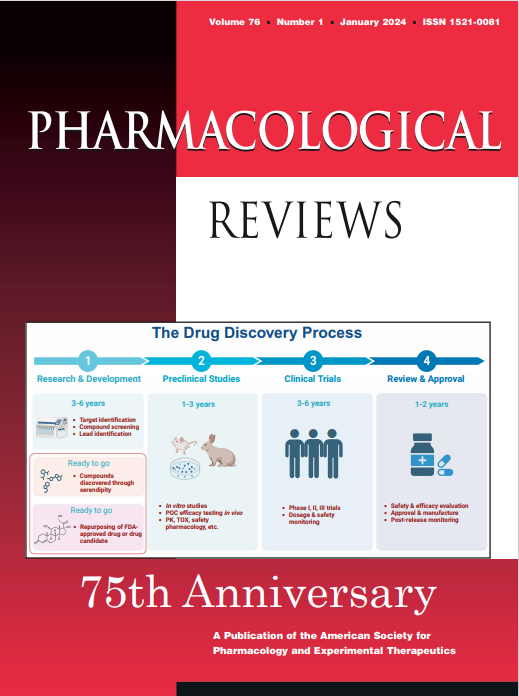国际基础与临床药理学联合会。CXVIII.非典型趋化因子受体(包括 ACKR5)命名法的更新。
IF 17.3
1区 医学
Q1 PHARMACOLOGY & PHARMACY
引用次数: 0
摘要
趋化因子通过经典的 G 蛋白偶联受体(GPCRs)发出信号,在发育、免疫平衡和多种疾病的过程中诱导细胞迁移。在过去十年中,非典型趋化因子受体(ACKRs)亚家族被从 GPCRs 中划分出来,因为它们不能触发传统的 G 蛋白信号或介导细胞迁移以响应趋化因子。不过,这些受体在趋化因子系统中发挥着重要作用,它们可以封存、运输或内化趋化因子,从而调节趋化因子的可用性并形成其梯度。GPR182 是最近被非形态化的趋化因子受体,与其近亲 ACKR3 有大约 30% 的序列相似性。GPR182 主要在内皮细胞上表达,被认为是一种清道夫,可调节 CXC、CC 和 XC 家族的大量趋化因子的可用性,并与 ACKR3 和 ACKR4 协同作用。与其他 ACKR 不同的是,GPR182 被证明与 β-阻遏蛋白有很强的组成性相互作用,这种相互作用是细胞内受体贩运和趋化因子清除所必需的。趋化因子与 GPR182 连接不会对 β-阿restin 的招募产生额外的可检测到的影响。基因消减 GPR182 会影响脾脏大小、骨髓造血和血清趋化因子水平,表明其在趋化因子平衡和免疫调节中的作用。据报道,GPR182 还能调节对血源性抗原和肿瘤发生的免疫反应。总之,令人信服的累积证据表明,GPR182 并不触发 G 蛋白介导的信号转导,而是在体外和体内充当趋化因子的清除剂,这有力地支持了将其作为 ACKR5 纳入趋化因子受体的系统命名法。意义声明 本文总结的研究结果有力地支持将 GPR182 命名为 ACKR5,并将其正式纳入非典型趋化因子受体家族。本文章由计算机程序翻译,如有差异,请以英文原文为准。
International Union of Basic and Clinical Pharmacology. CXVIII. Update on the Nomenclature for Atypical Chemokine Receptors including ACKR5.
Chemokines signal through classical G protein-coupled receptors (GPCRs) to induce cell migration during development, immune homeostasis and multiple diseases. Over the last decade a subfamily of atypical chemokine receptors (ACKRs) was delineated from GPCRs based on their inability to trigger conventional G protein signaling or mediate cell migration in response to chemokines. These receptors nevertheless play an important role within the chemokine system by sequestering, transporting or internalizing chemokines thereby regulating their availability and shaping their gradients. GPR182, the recently deorphanized chemokine receptor, shares about 30% of sequence similarity with its closest relative ACKR3. GPR182 is mainly expressed on endothelial cells and was proposed to act as a scavenger regulating the availability of a large set of chemokines from the CXC, CC and XC families and to act cooperatively with ACKR3 and ACKR4. Unlike other ACKRs, GPR182 was shown to have a strong constitutive interaction with β-arrestins that is required for intracellular receptor trafficking and chemokine scavenging. Chemokine ligation of GPR182 has no additional detectable impact on β-arrestin recruitment. Genetic ablation of GPR182 affects spleen size, myelopoiesis, and serum chemokine levels, indicating its role in chemokine homeostasis and immune regulation. GPR182 was also reported to regulate immune responses to bloodborne antigens and tumorigenesis. Taken together, compelling cumulative evidence indicates that GPR182 does not trigger G protein-mediated signaling but acts as a scavenger for chemokines in vitro and in vivo strongly supporting its inclusion as ACKR5 in the systematic nomenclature of chemokine receptors. Significance Statement The summarized presented findings strongly support the designation of GPR182 as ACKR5 and its formal inclusion in the family of atypical chemokine receptors.
求助全文
通过发布文献求助,成功后即可免费获取论文全文。
去求助
来源期刊

Pharmacological Reviews
医学-药学
CiteScore
34.70
自引率
0.50%
发文量
40
期刊介绍:
Pharmacological Reviews is a highly popular and well-received journal that has a long and rich history of success. It was first published in 1949 and is currently published bimonthly online by the American Society for Pharmacology and Experimental Therapeutics. The journal is indexed or abstracted by various databases, including Biological Abstracts, BIOSIS Previews Database, Biosciences Information Service, Current Contents/Life Sciences, EMBASE/Excerpta Medica, Index Medicus, Index to Scientific Reviews, Medical Documentation Service, Reference Update, Research Alerts, Science Citation Index, and SciSearch. Pharmacological Reviews offers comprehensive reviews of new pharmacological fields and is able to stay up-to-date with published content. Overall, it is highly regarded by scholars.
 求助内容:
求助内容: 应助结果提醒方式:
应助结果提醒方式:


